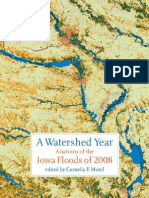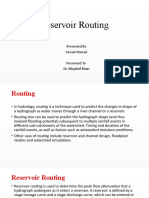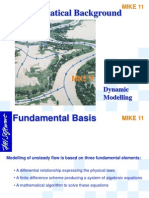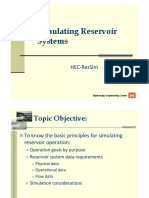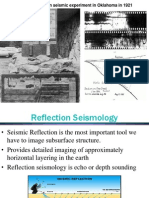07 Reservoir Sedimentation
07 Reservoir Sedimentation
Uploaded by
Reka Dwi AdiyasaCopyright:
Available Formats
07 Reservoir Sedimentation
07 Reservoir Sedimentation
Uploaded by
Reka Dwi AdiyasaCopyright
Available Formats
Share this document
Did you find this document useful?
Is this content inappropriate?
Copyright:
Available Formats
07 Reservoir Sedimentation
07 Reservoir Sedimentation
Uploaded by
Reka Dwi AdiyasaCopyright:
Available Formats
Prepared by: SURIPIN, MAGISTER TEKNIK SIPIL UNDIP
CONSEQUENCES OF RESERVOIR SEDIMENTATION
1. Upsstream
1) Storage loss
2) Delta deposition
3) Navigation
4) Air pollution
5) Earthquake hazards
6) Abrasion
7) Energy loss
8) Intake and outlet problems
9) ecology
2. Downstream
1) Stream morphology
2) Channel degradation
3) Hydraulic structures stability
4) Coastline abrasion
Fig. 12-1.
Prepared by: SURIPIN, MAGISTER TEKNIK SIPIL UNDIP
1. Deposit Patterns
1) Depositional Zones
2) Longitudinal Deposit Geometry
3) Lateral Deposition Patterns
4) Layered Deposits
5) Influence of Regulation Regime
6) Shoreline Erosion and Landslide
2. Reservoir Capacity Surveys
1) Types of Surveys
2) Survey Intervals
3) Survey Techniques
4) Survey Errors
3. Reservoirs Releasing and Trapping Efficiency
1) Brune Curve
2) Churchill Method
RESERVOIR SEDIMENTATION
Fig. 12-2.
Prepared by: SURIPIN, MAGISTER TEKNIK SIPIL UNDIP
PROSES SEDIMENTASI WADUK
1. Inflow Sedimen
1) Hidrology
a. Erosi lahan
b. Sediemnt delivery Ratio
c. Yil Sediemen
2) Sedimentology
a. Sediment Rating Curve
b. Debit
c. Karakteristik Sedimen Dasar
d. Penampang Sungai
2. Trap Efficiency
a. Brune
b. Churchil
3. Distribusi Sedimen
Prepared by: SURIPIN, MAGISTER TEKNIK SIPIL UNDIP
POLA PENGENDAPAN SEDIMEN
Pada dasarnya pola pengendapan sedimen di dalam waduk
sangat bervariasi tergantung pada kondisi hidrologi,
karakteristik sedimen (grain size), geometri waduk, dan pola
operasi waduk.
Pola pengendapan sedimen di waduk secara horizontal dapat
dibedakan menjadi 4 kelompok, yaitu
1. Delta deposits
2. Wedge-shaped deposits
3. Tepering deposits, dan
4. Uniform deposits.
Prepared by: SURIPIN, MAGISTER TEKNIK SIPIL UNDIP
POLA PENGENDAPAN SEDIMEN
Topset bed Bottomset bed
Foreset bed
Muka air maksimum
Muka air normal
Delta deposit
Muddy Lake deposits
Pivot point
Pola umum pengendapan sedimen di waduk
Pada saat aliran sungai memasuki genangan
waduk, kecepatan arus menurun, dan
beban sedimen mulai mengendap.
Sedimen dasar dan sebagian sedimen layang yang kasar mengendap
lebih dulu membentuk delta, sementara sedimen halus diangkut lebih
jauh ke lokasi yang lebih dalam.
Fig. 12-3.
Prepared by: SURIPIN, MAGISTER TEKNIK SIPIL UNDIP
Sedimen yang masuk terdiri dari sedimen kasar, yang segera
mengendap di zona inflow (muara). Komposisi sedimen
hampir semuanya material kasar (d>0,062 mm), tetapi juga
dimungkinkan berisi sedimen yang lebih halus seperti silt.
POLA PENGENDAPAN SEDIMEN
Delta Deposits
Fig. 12-4.
Prepared by: SURIPIN, MAGISTER TEKNIK SIPIL UNDIP
Sedimen yang masuk terdiri dari sedimen halus, yang terangkut sampai
dekat bendungan oled turbidity currents. Bentuk ini juga ditemukan pada
waduk-waduk kecildengan inflow sedimen halus yang tinggi, dan juga
reservoir besar dengan pola operasi air rendah pada kejadian banjir, yang
menyebabkan sebagian besar sedimen terbawa sampai mendekati
bendungan.
POLA PENGENDAPAN SEDIMEN
Wedge-shaped Deposits
Fig. 12-5.
Prepared by: SURIPIN, MAGISTER TEKNIK SIPIL UNDIP
Tipe ini terjadi manakala sedimen yang mengendap makin
mendekati bendungan makin menipis. Bentuk ini biasanya
terjadi pada baduk yang sangat panjang dan dioperasikan
pada muka air tinggi.
POLA PENGENDAPAN SEDIMEN
Tapering Deposits
Fig. 12-6.
Prepared by: SURIPIN, MAGISTER TEKNIK SIPIL UNDIP
Bentuk ini tidak umum tapi dapat terjadi. Waduk sempit
dengan pola operasi muka air yang berfluktuasi dan dengan
masukan sedimen halus sedikit berpotensi terjadi endapan
sedimen yang hampir merata (uniform).
POLA PENGENDAPAN SEDIMEN
Uniform Deposits
Fig. 12-7.
Prepared by: SURIPIN, MAGISTER TEKNIK SIPIL UNDIP
SURVEY KAPASITAS WADUK
Survey kapasitas waduk secara berulang digunakan untuk
menentukan volume sedimen, pola pengendapan sedimen,
kurva hubungan antara tinggi vs kapasitas dan tinggi vs luas
genangan.
Dengan mengkonversi volume ke berat sedimen berbasis
pada berat jenis, dan memperhitungkan trap efficiency, yil
sedimen dari DAS dapat dikitung.
Survey waduk dapat dibedakan menjadi:
1. Survey kontur
2. Survey penampang melintang (range surveys)
Prepared by: SURIPIN, MAGISTER TEKNIK SIPIL UNDIP
SURVEY KAPASITAS WADUK
Survey kontur
Survey memerlukan informasi topografi dan bathimetri nyang lebih
lengkap untuk membuat peta kontur dasar waduk.
Cara ini merupakan yang paling akurat dalam menentukan volume waduk,
dan memberikan informasi npaling lengkap mengenai distribusi sedimen
dalam waduk.
Perkebangan peralatan terkini, dengan menggunakan alat pengukur
kedalaman otomatis (ecosounding) dan penentuan posisi otomatis (GPS),
memungkinkan survey kontur ini lebih dapat dilaksanakan lebih cepat dan
ekonomis.
Volume dihitung dengan persamaan:
atau
Dimana: H = beda elevasi antar kontur terdekat, A1 dan A2 luas
permukaan yang dilingkupi masing-masing garis kontur
( )
2
A A H
Volume
2 1
+
=
( ) | |
3
A A A A H
Volume
2 2 1 1
2
1
+ + +
=
Prepared by: SURIPIN, MAGISTER TEKNIK SIPIL UNDIP
SURVEY KAPASITAS WADUK
Survey penampang melintang (range survey)
Survey cara ini memerlukan sejumlah lokasi penampang
melintang yang permanen sebagai lokasi survey dan untuk
disurvey ulang berikutnya, dan untuk menghitung perubahan
kapasitas waduk antar survey dengan pers geometris.
Bagian yang tergenang disurvey dengan teknik hidrografi dan
bagian di atas muka air disurvey secara terrestrial biasa.
Pelaksanaan range survey lebih cepat dan lebih ekonomis
dibandingkan contour survey, karena data lapangan yang
diperlukan lebih sederhana dibandingkan contour survey.
Range survey banyak digunakan tempo dulu, saat ini mulai
digantikan dengan contour survey, karena hasilnya lebih
lengkap dan akurat.
Prepared by: SURIPIN, MAGISTER TEKNIK SIPIL UNDIP
SURVEY KAPASITAS WADUK
Interval Surveys
Interval survey waduk harus didasarkan pada karakteristik
individual waduk.
Pada waduk yang penurunan kapasitasnya sangat lambat,
interval survey 20 tahunan atau lebih dapat diterima,
sebaliknya pada waduk yang mengalami sedimentasi tinggi,
atau manajemen sedimen akan dievaluasi, maka interval
survey dapat dilakukan 2 atau 3 tahun.
Survey dan pengambilan sampel sedimen harus dilakukan
setelah terjadinya banjir besar.
Survey juga harus dilakukan segera jika di hulu waduk
tersebut beroperasi waduk baru.
Prepared by: SURIPIN, MAGISTER TEKNIK SIPIL UNDIP
RESERVOIR RELEASING & TRAPPING EFFICIENCY
The sediment release efficiency of a reservoir is the
mass ratio of the released sediment to the total
sediment inflow over a specified time period.
Release Efficiency = 1 trap efficiency
Empircal relationship on the concept of sediment
releasing have been developed by:
Churchill (1948), dan
Brune (1953)
Prepared by: SURIPIN, MAGISTER TEKNIK SIPIL UNDIP
RESERVOIR RELEASING & TRAPPING EFFICIENCY
Churchill (1948)
Mengembangan hubungan antara efisiensi pelepasan
sedimen dan indeks sedimentasi waduk, yang didifinisikan
sebagai nisbah antara periode retensi dan kecepatan rata-
rata aliran melalui waduk.
Data minimal yang diperlukan untuk keperluan ini adalah:
o Kapasitas tampungan: kapasitas pada elevasi pada operasi rata-rata
(m3).
o Inflow tahunan: inflow harian rata-rata selama periode studi (m3/s)
o Periode retensi: kapasitas dibagi inflow rata-rata (s)
o Panjang waduk: panjang waduk pada elevasi operasi rata-rata (m)
o Kecepatan air: kecepatan rata-rata, dengan mebagi inflow dengan
penampang melintang rata-rata (m/s)
o Index sedimentasi: periode retensi dibagi kecepatan.
Prepared by: SURIPIN, MAGISTER TEKNIK SIPIL UNDIP
RESERVOIR RELEASING & TRAPPING EFFICIENCY
Brune (1953)
Mengembangan hubungan empiris untuk mengestimasi trap
efficiency jangka panjang pada waduk yang digenangi secara
normal, didasarkan pada hubungan antara : rasio kapasitas
dan inflow, dan trap efficiency.
Metode ini dipakai secara luas untuk mengestimasi retensi
sedimen di waduk, dan memberikan hasil yang memadai
dengan data yang sangat terbatas untuk : volume tampungan,
dan inflow tahunan.
Terbatas hanya untuk kondisi rata-rata jangka panjang.
Prepared by: SURIPIN, MAGISTER TEKNIK SIPIL UNDIP
RESERVOIR RELEASING & TRAPPING EFFICIENCY
Trap efficiency of reservoirs after Brune (1953).
Fig. 12-8.
Prepared by: SURIPIN, MAGISTER TEKNIK SIPIL UNDIP
RESERVOIR RELEASING & TRAPPING EFFICIENCY
Trap efficiency of reservoirs after Brune (1953), dan Churchill (1948).
Fig. 12-9.
Prepared by: SURIPIN, MAGISTER TEKNIK SIPIL UNDIP
RESERVOIR RELEASING & TRAPPING EFFICIENCY
Spesific weight of reservoir deposit:
W=W
C
P
C
+W
M
P
M
+W
S
P
S
where:
W = specific weight (kg/m3)
P
C
, P
M
, P
S
= percentage of clay, silt, and sand, respectively
W
C
, W
M
, W
S
= initial weight for clay, silt, and sand, respectively
1. Continuously submerged
2. Periodic drawdown
3. Normally empty reservoir
4. Riverbed sediment
Prepared by: SURIPIN, MAGISTER TEKNIK SIPIL UNDIP
RESERVOIR RELEASING & TRAPPING EFFICIENCY
Sediment Compaction
W=W
1
+K logt
where:
W = specific weight of a deposit with an age of t years
W
1
= initial weight, usually taken to be the value after 1 year of
consolidation, and
K = constant
( )
(
+ = 1 t ln
1 t
t
B 4343 , 0 W W
1 t
Prepared by: SURIPIN, MAGISTER TEKNIK SIPIL UNDIP
EMPIRICAL PREDICTION OF DEPOSITION PATTERNS
Sediments are deposited in reservoirs at all elevations,
causing the stage capacity curve to shift.
Empirical methods have developed to distribute sediment
deposits within a reservoir as a function of depth, thereby
projecting the shift in the stage-storage curve.
When sediment survey data are available for an existing
reservoir, the observed deposition pattern can be used to
select the proper empirical relationship to compute the
future shift in the stage-area and stage-capacity relationship.
Limitation: empirical methods do not identify the specific
location in a reservoir which will be affected by sediment;
they predict only the change in the stage-area and stage-
capacity curves.
Prepared by: SURIPIN, MAGISTER TEKNIK SIPIL UNDIP
EMPIRICAL PREDICTION OF DEPOSITION PATTERNS
Deposit in flood control pool
Reservoir levels are normally held below the flood control
level, resulting in small amounts of sediment accumulation in
then portion of theimpoundment between the normal and
maximum (flood) pool level.
However, because a large amounts of sediment can be
delivered during flood, and if the pool level is held above the
normal pool for a significant period of time a substantial
amount of sediment may be deposited in this zone.
Prepared by: SURIPIN, MAGISTER TEKNIK SIPIL UNDIP
EMPIRICAL PREDICTION OF DEPOSITION PATTERNS
Fig. 12-10. Percent of
Sediemnt Trapped
within flood control
pool (Strand and
Pemberton, 1987)
Prepared by: SURIPIN, MAGISTER TEKNIK SIPIL UNDIP
EMPIRICAL PREDICTION OF DEPOSITION PATTERNS
Area-Increament and Empirical Area Reduction Methods
Empirical method to distribute sediment below the normal pool
elevation developed by the US Bureau of Reclamation have been
widely used. They are 4 steps process:
1. Determine the amount of sediment to be distributed.
2. On the basis of the site characteristics, select the
appropriate empirical curve for sediment distribution.
3. Determine the hight sediment accumulation ath the dam,
termed the new-zero-capacity elevation
4. Use the selected empirical curve to distribute sediment as a
function of depth above the new-zero-capacity elevation
Prepared by: SURIPIN, MAGISTER TEKNIK SIPIL UNDIP
EMPIRICAL PREDICTION OF DEPOSITION PATTERNS
Fig. 12-11. type
curves for the
empirical area-
reduction method
for estimating
storage loss due to
sediment deposition
(Strand and
Pemberton, 1987)
Prepared by: SURIPIN, MAGISTER TEKNIK SIPIL UNDIP
EMPIRICAL PREDICTION OF DEPOSITION PATTERNS
1. Determine Sediment Inflow
The sediment volume should be distributed within the reservoir must
be determined. At this example, the sediment survey data were
extrapolated to determine an average volume loss of 330 Mm
3
per 100
years.
Hydrographic survey
Sedimentologic survey
Hydrologic survey
Prepared by: SURIPIN, MAGISTER TEKNIK SIPIL UNDIP
EMPIRICAL PREDICTION OF DEPOSITION PATTERNS
2. Select Design Curve
a) Plot the original depth capacity relationship on log-log paper and
calculate the slope m of the fitted line, which is the reciprocal of the
slope of the depth vs capacity (Fig. 12-12.)
Fig. 12-12. reservoir
depth-capacity
relationship as used
in the empirical
area-reduction
method (Strand and
Pemberton, 1987)
1
10
100
1000
0 1 10 100 1.000 10.000
Kapasitas, 10
6
m
3
K
e
d
a
l
a
m
a
n
,
m
m = 3 Type II
Prepared by: SURIPIN, MAGISTER TEKNIK SIPIL UNDIP
EMPIRICAL PREDICTION OF DEPOSITION PATTERNS
Reservoir shape Type m
Lake I 3.5 4.5
Floodplain foothill II 2.5 3.5
Hill and gorge III 1.5 2.5
Gorge IV 1.0 1.5
2. Select Design Curve
b) Use the resulting slope m to classify the reservoir shape using the
tabel below.
Prepared by: SURIPIN, MAGISTER TEKNIK SIPIL UNDIP
EMPIRICAL PREDICTION OF DEPOSITION PATTERNS
2. Select Design Curve
c) Classify the reservoir operation as stable pool, moderate drawdown,
considerable drawdown, or normally empty. Giving equal weight to
reservoir shape and reservoir operation, determine the weighted
reservoir type from tabel below.
Prepared by: SURIPIN, MAGISTER TEKNIK SIPIL UNDIP
EMPIRICAL PREDICTION OF DEPOSITION PATTERNS
3. Compute new zero-capacity elevation at dam
Use the original elevation-area and capacity curve to compute the
value of the dimensionless function F at several different pool elevation
in the deeper part of the reservoir.
h
h
HA
V S
F
=
Dimana S = total sedimen deposition (330 Mm
3
), V
h
= reservoir
capacity (m
3
) from column 3 of each elevation h from column 1, H =
original depth of reservoir below normal pool (71.3 m), A
h
=
reservoir area (m
2
, from column 2) at given elevation h.
Prepared by: SURIPIN, MAGISTER TEKNIK SIPIL UNDIP
EMPIRICAL PREDICTION OF DEPOSITION PATTERNS
Fig. 12-13. type curve
for determining the
new zero depth at the
dam based on the
dimensionless F
function. The value for
each of the type curves
are shown in both
graphical and tabular
form (Strand and
Pemberton, 1987)
0,001
0,01
0,1
1
10
100
1000
0,00 0,10 0,20 0,30 0,40 0,50 0,60 0,70 0,80 0,90 1,00
Relative Depth (p)
D
i
m
e
n
s
i
o
n
l
e
s
s
F
u
n
c
t
i
o
n
(
F
)
Prepared by: SURIPIN, MAGISTER TEKNIK SIPIL UNDIP
EMPIRICAL PREDICTION OF DEPOSITION PATTERNS
I II III IV p F
0,00 0 0,000
0,01 996,7 5,568 12,03 0,2023 0,034
0,02 277,5 3,758 5,554 0,2330 0,077
0,05 51,49 2,233 2,057 0,2716 0,120
0,10 14,53 1,495 1,013 0,2911 0,162 2,6681
0,15 6,971 1,169 0,6821 0,2932 0,205 1,6172
0,20 4,143 0,9706 0,5180 0,2878 0,248 1,0382
0,25 2,766 0,8299 0,4178 0,2781 0,284 0,7483
0,30 1,980 0,7212 0,3486 0,2656 0,333 0,4708
0,35 1,485 0,6323 0,2968 0,2513 0,376 0,3040
0,40 1,149 0,5565 0,2555 0,2355 0,419 0,1974
0,45 0,9076 0,4900 0,2212 0,2187 0,462
0,50 0,7267 0,4303 0,1917 0,2010 0,504
0,55 0,5860 0,3756 0,1657 0,1826 0,547
0,60 0,4732 0,3255 0,1422 0,1537 0,590
0,65 0,3805 0,2780 0,1207 0,1443 0,633
0,70 0,3026 0,2333 0,1008 0,1245 0,675
0,75 0,2359 0,1907 0,08204 0,1044 0,718
0,80 0,1777 0,1500 0,06248 0,08397 0,761
0,85 0,1262 0,1107 0,04731 0,06330 0,803
0,90 0,08011 0,07276 0,03101 0,04239 0,846
0,95 0,03830 0,03590 0,01527 0,02128 0,889
0,98 0,01494 0,01425 0,006057 0,008534 0,932
0,99 0,007411 0,00711 0,003020 0,002470 0,974
1,00 0,0 0,00 0,0 0,0 1,000
Examples F Values for Type
p
Prepared by: SURIPIN, MAGISTER TEKNIK SIPIL UNDIP
EMPIRICAL PREDICTION OF DEPOSITION PATTERNS
4. Distribute Sediment
The specified volume of trapped sediment is distributed within the
reservoir according to the selected type curve. Compute the values for
the relative sediment area a (column #6) at each relative depth p using
the appropriate equation:
Type I :
( )
36 , 0
85 , 1
p 1 p 047 , 5 a =
( )
41 , 0
57 , 0
p 1 p 487 , 2 a =
( )
32 , 2
15 , 1
p 1 p 967 , 16 a =
Type II :
Type III :
Type IV : ( )
34 , 1
25 , 0
p 1 p 486 , 1 a =
Prepared by: SURIPIN, MAGISTER TEKNIK SIPIL UNDIP
STAGE-CAPACITY & STAGE-AREA CURVES
570
580
590
600
610
620
630
640
650
660
0 250 500 750 1.000 1.250 1.500 1.750 2.000
Kapasitas, 10
6
m
3
E
l
e
v
a
s
i
,
m
0 1.000 2.000 3.000 4.000 5.000 6.000 7.000 8.000
Luas Genangan, ha
Prepared by: SURIPIN, MAGISTER TEKNIK SIPIL UNDIP
TUGAS
1. Data yang diperlukan:
Pilih salah satu sungai di Indonesia, lebih baik yang ada waduk
atau rencana waduk, dengan data berupa al:
Peta DAS, termasuk waduk
Data debit atau muka air dan pengukuran debit, beserta
penampang melintang dan memanjang sungai
Data pengukuran konsentrasi sedimen layang
Data karakteristik sedimen dasar.
2. Hitung Sedimentasi Waduk/Perkiraan Umur waduk
Menghitung sedimen inflow, lengkung sedimen
Trap efficiency
Distribusi sedie=men di waduk.
You might also like
- Dam Safety PDFDocument51 pagesDam Safety PDFAndyara DuarteNo ratings yet
- Flood PDFDocument274 pagesFlood PDFgetafix3No ratings yet
- Reservoir Routing Presentation by Fawad AhmadDocument12 pagesReservoir Routing Presentation by Fawad AhmadFawad Ahmad KhanNo ratings yet
- Flow RegimeDocument5 pagesFlow RegimeMuhammad Tidar WirayudhaNo ratings yet
- Lecture 6.flood Frequency AnalysisDocument37 pagesLecture 6.flood Frequency AnalysisLestor NaribNo ratings yet
- Management of Reservoir Sedimentation - TurkeyDocument210 pagesManagement of Reservoir Sedimentation - TurkeyBikesh ShresthaNo ratings yet
- Hec-Ressim Enhancements: Better Tools To Simulate The Operation of California ReservoirsDocument32 pagesHec-Ressim Enhancements: Better Tools To Simulate The Operation of California ReservoirsJoaquín FernándezNo ratings yet
- The Shallow Water Equations Derivation ProcedureDocument23 pagesThe Shallow Water Equations Derivation Procedurestanculeanu100% (1)
- 4676 Dam Breach Modeling With Unsteady Hec Ras Common Techniques and Assumptions Compared - 1 PDFDocument29 pages4676 Dam Breach Modeling With Unsteady Hec Ras Common Techniques and Assumptions Compared - 1 PDFNguyen Ngo Quang Trung100% (1)
- Flow Duration CurveDocument6 pagesFlow Duration CurveMakhdoom AamirNo ratings yet
- Groundwater Part IIDocument49 pagesGroundwater Part IIPeter Riad100% (1)
- Brochure Delft3D Flexible Mesh SuiteDocument8 pagesBrochure Delft3D Flexible Mesh Suiteabdul malik al fatahNo ratings yet
- River Flood Modelling For Nzoia River - A Quasi 2-D ApproachDocument14 pagesRiver Flood Modelling For Nzoia River - A Quasi 2-D Approachsalt2009No ratings yet
- Xbeach ManualDocument106 pagesXbeach ManualGustavo GomesNo ratings yet
- Modeling Sediment Erosion and Deposition With The FLOW-3D Sedimentation & Scour ModelDocument22 pagesModeling Sediment Erosion and Deposition With The FLOW-3D Sedimentation & Scour Modelozzy22No ratings yet
- Materi Kuliah Analisa Trnasportasi Sedimen ContohDocument24 pagesMateri Kuliah Analisa Trnasportasi Sedimen ContohRizka ArbaningrumNo ratings yet
- Mathematical Background: 1-D Dynamic ModellingDocument24 pagesMathematical Background: 1-D Dynamic ModellingThaine Herman Assumpção100% (1)
- How To Work in SPEI R PackageDocument17 pagesHow To Work in SPEI R Packagesophisant_1No ratings yet
- 02lecture ReservoirsDocument36 pages02lecture Reservoirsdeivarajeshkrishna50% (2)
- L 01 SimulatingReservoirSystemsDocument23 pagesL 01 SimulatingReservoirSystemsManuel SueroNo ratings yet
- Poster Presentation For Watershed DelinationDocument1 pagePoster Presentation For Watershed DelinationTek Bahadur KshetriNo ratings yet
- Listric Normal FaultsDocument15 pagesListric Normal FaultsVaibhavSinghalNo ratings yet
- Dams in Japan Overview 2015Document30 pagesDams in Japan Overview 2015Kakamam MahmoodNo ratings yet
- Flood Hazard and Risk Assessment Using GIS and Remote Sensing in Fogera Woreda, Northwest EthiopiaDocument28 pagesFlood Hazard and Risk Assessment Using GIS and Remote Sensing in Fogera Woreda, Northwest EthiopiaHery Setiawan PurnawaliNo ratings yet
- Application of Groundwater FlowDocument25 pagesApplication of Groundwater Flowfuji100% (1)
- Ch9 - Tidal Flat Depositional SystemDocument41 pagesCh9 - Tidal Flat Depositional Systemanima1982No ratings yet
- Andinet WmeskelDocument104 pagesAndinet WmeskelEba AjemaNo ratings yet
- Diversionheadworkm3 120625052707 Phpapp02Document66 pagesDiversionheadworkm3 120625052707 Phpapp02Manikanta ReddyNo ratings yet
- 3-D Seismic Attributes: Dan Gr. Vetrici and Robert R. StewartDocument30 pages3-D Seismic Attributes: Dan Gr. Vetrici and Robert R. Stewartmichael2k7849100% (1)
- Hec-Hms: The Hydrologic Engineering Center's Hydrologic Modeling System (HMS)Document62 pagesHec-Hms: The Hydrologic Engineering Center's Hydrologic Modeling System (HMS)Intu ShresthaNo ratings yet
- NRECA Water BalanceDocument54 pagesNRECA Water BalanceGneis Setia GrahaNo ratings yet
- Floods:: Flood RoutingDocument18 pagesFloods:: Flood RoutingGetnet GirmaNo ratings yet
- First Reflection Seismic Experiment in Oklahoma in 1921Document59 pagesFirst Reflection Seismic Experiment in Oklahoma in 1921Ezzadin BabanNo ratings yet
- Embankment Dam Breach Parameters and Their Uncertainties: David C. Froehlich, PH.D., P.E., M.ASCEDocument14 pagesEmbankment Dam Breach Parameters and Their Uncertainties: David C. Froehlich, PH.D., P.E., M.ASCEJason CZNo ratings yet
- Contents Book 2 Part 1Document17 pagesContents Book 2 Part 1Zerihun AlemayehuNo ratings yet
- Swat Modflow TutorialDocument56 pagesSwat Modflow TutorialfrenkiNo ratings yet
- Lab 06 - Static CorrectionsDocument4 pagesLab 06 - Static Correctionsapi-323770220No ratings yet
- CEF352 Chap3 v1Document26 pagesCEF352 Chap3 v1Tabi JosephNo ratings yet
- CH Lecture 1Document54 pagesCH Lecture 1Sohail SakhaniNo ratings yet
- Green EarthDocument40 pagesGreen EarthsanthiyaperemelNo ratings yet
- Hydrologic ModelsDocument33 pagesHydrologic ModelsbhagavathamNo ratings yet
- ANNEXURE VBDocument16 pagesANNEXURE VBCIDCONMIA.COMNo ratings yet
- Hydrology 3Document120 pagesHydrology 3ZoSo90No ratings yet
- Economic Analysis and Application of Small Micro/Hydro Power PlantsDocument8 pagesEconomic Analysis and Application of Small Micro/Hydro Power Plantsjan boviNo ratings yet
- Tips On Using Hec Ras in DambreakDocument31 pagesTips On Using Hec Ras in Dambreakmushroom0320No ratings yet
- FM 4 Fluid Kinematics CompleteDocument48 pagesFM 4 Fluid Kinematics Completeالياس يونس مرغلانيNo ratings yet
- Reservoir SedimentationDocument8 pagesReservoir Sedimentationmiguelangel1986100% (1)
- Geological ModelingDocument27 pagesGeological ModelingMustapha BouregaaNo ratings yet
- Guide ResSimDocument21 pagesGuide ResSimrajesh005No ratings yet
- CIE5450 Hydrology Flood Routing Part2 PDFDocument20 pagesCIE5450 Hydrology Flood Routing Part2 PDFJohn E Cutipa L100% (1)
- 2011 AquaResource IntegratedModellingGuideDocument116 pages2011 AquaResource IntegratedModellingGuidemaribo2005No ratings yet
- Derivation of Unit HydrographDocument4 pagesDerivation of Unit HydrographNitesh 19CV46No ratings yet
- Hydrology Topic-3Document7 pagesHydrology Topic-3wanradhiahNo ratings yet
- Time of Concentration (NRCS)Document16 pagesTime of Concentration (NRCS)Muhammad NaufalNo ratings yet
- Assignment Four''system Tracts''Document9 pagesAssignment Four''system Tracts''Nirajan PandeyNo ratings yet
- HowTo Analyse AnglesDocument5 pagesHowTo Analyse Anglesbidyut_iitkgpNo ratings yet
- Oleh/By: Irfan Budi Pramono, Nining Wahyuningrum, Dan/and Agus WuryantaDocument16 pagesOleh/By: Irfan Budi Pramono, Nining Wahyuningrum, Dan/and Agus WuryantaZoelQivlyeNo ratings yet
- Chapter10 Spherical Triangle For GCDocument3 pagesChapter10 Spherical Triangle For GCAmit Kumar SenNo ratings yet
- SWAT-MODFLOW Workshop: Prepared byDocument78 pagesSWAT-MODFLOW Workshop: Prepared byDaniel Antunez100% (1)
- Unidad 7Document3 pagesUnidad 7DAISY ADRIANA SANCHEZ MOYANONo ratings yet
- 1.water Distiller BrochureDocument4 pages1.water Distiller BrochureJorge CuevasNo ratings yet
- High Pressure Boiler ChemistryDocument67 pagesHigh Pressure Boiler ChemistryJayanath Nuwan Sameera100% (2)
- Câu Hỏi Ôn Luyện Cho Cuộc Thi "Rung Chuông Vàng 2023 " Tại Trường Thpt Ngô Quyền-Ba Vì-HnDocument7 pagesCâu Hỏi Ôn Luyện Cho Cuộc Thi "Rung Chuông Vàng 2023 " Tại Trường Thpt Ngô Quyền-Ba Vì-HnChu Ngọc LinhNo ratings yet
- Aashto M304 2Document2 pagesAashto M304 2David SolisNo ratings yet
- SeawaterDocument6 pagesSeawatercandra trisilawatiNo ratings yet
- Science 7-LONG QUIZ 4Document4 pagesScience 7-LONG QUIZ 4Filii ZamorensisNo ratings yet
- Industrial Pollution and ControlDocument3 pagesIndustrial Pollution and ControlChanduNo ratings yet
- Copernicus4regions 2018Document141 pagesCopernicus4regions 2018Helmer Edgardo Monroy GonzálezNo ratings yet
- Coated Film: PVDC Is A Material Known To Have A Low Environmental ImpactDocument2 pagesCoated Film: PVDC Is A Material Known To Have A Low Environmental ImpactdanceNo ratings yet
- HB 4944 - DWRWRC BillDocument47 pagesHB 4944 - DWRWRC Billpaomillan0423No ratings yet
- How To Solve Pipes and Tanks Cisterns ProblemsDocument5 pagesHow To Solve Pipes and Tanks Cisterns ProblemsRamanathan InNo ratings yet
- Lesson 16 - Energy Sources Fact SheetDocument2 pagesLesson 16 - Energy Sources Fact Sheetapi-212901753No ratings yet
- Environmental Problems in Dyeing.Document133 pagesEnvironmental Problems in Dyeing.saidurtexNo ratings yet
- LMG GeographyDocument7 pagesLMG GeographyDARK_X_NOVANo ratings yet
- WWW BIOCOS BrochureDocument4 pagesWWW BIOCOS BrochureivanvulicNo ratings yet
- 2-Ethylhexanol: 2-Ethylhexanol Safety Data SheetDocument8 pages2-Ethylhexanol: 2-Ethylhexanol Safety Data SheetmishaNo ratings yet
- Photo Essay WritingDocument2 pagesPhoto Essay WritingJoefrel AlipinNo ratings yet
- Urea EnciclopediaDocument36 pagesUrea EnciclopediaJuan Pablo Correa UribeNo ratings yet
- Literature ReviewmainDocument9 pagesLiterature ReviewmainSubbaReddyNo ratings yet
- 2021 NZ Biofouling 2nd-Edition 1Document10 pages2021 NZ Biofouling 2nd-Edition 1Pippo TopolinoNo ratings yet
- E Book Mud Therapy TheoryDocument1 pageE Book Mud Therapy Theoryvinda astri permatasariNo ratings yet
- Earth and Life PPT 2Document24 pagesEarth and Life PPT 2Sunsilk Na GreenNo ratings yet
- POGIL - Nutrient CycleDocument8 pagesPOGIL - Nutrient CycleMICHAEL MASONNo ratings yet
- Akhter Wasa Bill PDFDocument1 pageAkhter Wasa Bill PDFAli100% (1)
- Sea Level RiseDocument18 pagesSea Level RiseomaransNo ratings yet
- GroundWaterInformation RANCHIDocument27 pagesGroundWaterInformation RANCHIAnonymous 1rpYBN8100% (1)
- River Meanders - Theory of Minimum VarianceDocument21 pagesRiver Meanders - Theory of Minimum VariancegeoecologistNo ratings yet
- HD ND ZUE - enDocument28 pagesHD ND ZUE - enwylie01No ratings yet

